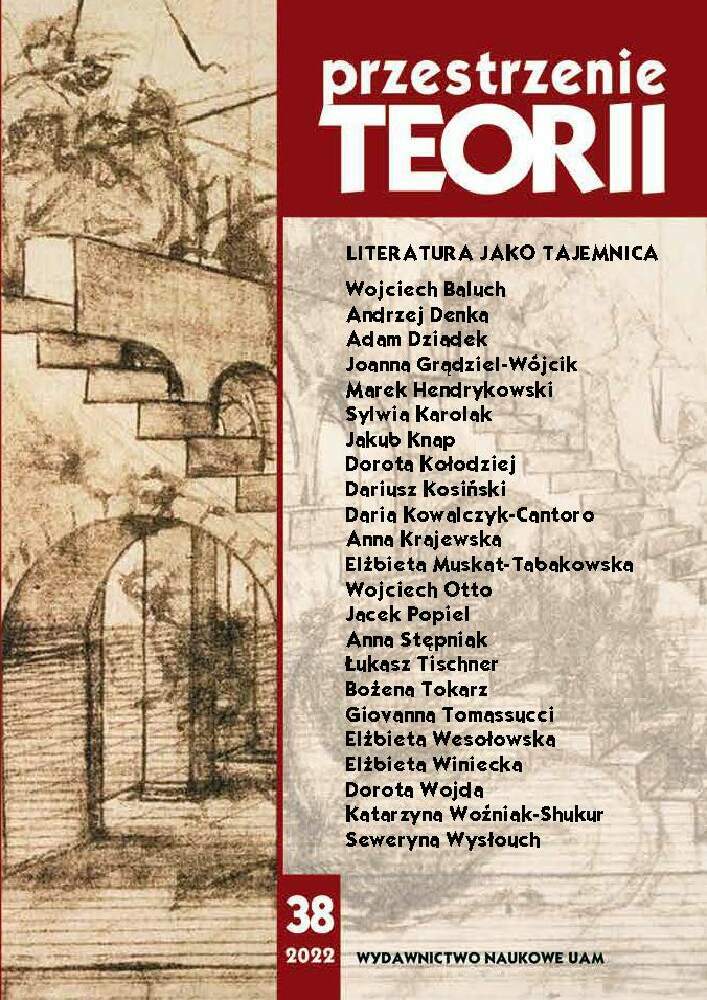Abstrakt
The paper attempts to introduce Polish readers to a theory presented by the American literary scholar Margaret Freeman in her recent book, The Poem as Icon (2020). In the monograph, Freeman analyzes ways in which the reader experiences reality – both visible and invisible – through poetry. Her fundamental assumption is that the relevant research question is not what literary art is, but how it comes to be what it is. The purpose of the present paper is to show that, although written by a literary scholar, the monograph corresponds to general tendencies that can be seen in contemporary humanities: in cognitive linguistics (in particular, Leonard Talmy’s theory of -ception and George Lakoff’s cognitive theory of metaphor), in the theory of linguistic picture of the world, or in discourse analysis. All these disciplines are based upon the assumption that the essence of the world is continuous change, and they investigate linguistic expressions in the process of becoming, which is relative to factors traditionally considered as non-linguistic. Freeman’s poetic cognition has a wide scope: it embraces cognitive processes of human mind, but also bodily and emotive cognition. Thus poetic cognition is embodied, and in Freemen’s theory a “poem-as-icon” ultimately becomes an illusion of the “here-and-now” direst experience.
Bibliografia
Bojarska K., Poczuć myślenie: afektywne procedury historii i krytyki (dziś), „Teksty Drugie” 2013, 6, s. 8–16.
Fauconnier G., Mental Spaces, Cambridge 1985.
Fischer O., Nänny M., Introduction: Iconicity as a Creative Force in Language Use, [w:] Form miming meaning, red. M. Nänny, O. Fischer, Amsterdam–Philadelphia 1999, s. xv–xxxvi.
Freeman M.H., Przekraczanie granic czasu: fenomenologia Merleau-Ponty’ego a teorie językoznawstwa kognitywnego, przeł. M. Majewska, „Przestrzenie Teorii” 2007 [2004], 8, s. 223–234.
Freeman M.H., The Poem as Icon, Oksford 2020.
Hiraga M., Metaphor and Iconicity. A Cognitive Approach to Analyzing Texts, Londyn 2005.
Johnson M., The Body in the Mind: The Bodily basis of Meaning, Imagination and Reason, Chicago 1987.
Kövecses Z., A New Look at Metaphorical Creativity in Cognitive Linguistics, „Cognitive Linguistics” 2010, 21.4, s. 663–697.
Kövecses Z., Extended Conceptual Metaphor Theory, Cambridge 2020.
Kruse F.E., Is Music a Pure Icon?, „Transactions of the Charles S. Peirce Society” 2007, 43/4, s. 626–635 (review of T.L. Short).
Lakoff G., Johnson M., Metafory w naszym życiu, przeł. T.P. Krzeszowski, Warszawa 1988 [1981].
Langacker R.W., Gramatyka kognitywna. Wprowadzenie, przekład zbiorowy, Kraków 2009 [2008].
Merleau-Ponty M., Widzialne i niewidzialne, przeł. M. Kowalska, Warszawa 1996.
Newen A. (1946) 1996, [w:] The Oxford Handbook of 4E Cognition, red. A. Newen, Sh. Gallagher, L. De Bruin, Oxford 2018.
Noth W., Icon and Iconicity, [w:] Handbook od Semiotics, Bloomington and Indianapolis 1995, s. 121–128.
Short T.L., Peirce’s Theory of Signs, Cambridge 2009 (2007).
Stockwell P., Cognitive Poetics, Londyn 2019 (2002).
Stockwell P., Poetyka kognitywna. Wprowadzenie, przeł. A. Skucińska, Kraków 2002.
Talmy L., Fictive motion in language and „ception”, [w:] Toward a Cognitive Semantics, Cambridge 2000, s. 99–176.
Ungerer F., Diagrammatic Iconicity in Word-Formation, [w:] Form miming meaning, red. M. Nänny, O. Fischer, Amsterdam–Philadelphia 1999, s. 308–324.
Licencja

Utwór dostępny jest na licencji Creative Commons Uznanie autorstwa – Użycie niekomercyjne – Bez utworów zależnych 4.0 Międzynarodowe.
Autorzy
Autorzy tekstów przyjętych do publikacji w czasopiśmie „Przestrzeniach Teorii” są zobowiązani do wypełnienia, podpisania i odesłania na adres redakcji umowy o udzielenie nieodpłatnej licencji do utworów, z zobowiązaniem do udzielania sublicencji CC.
Zgodnie z umową, autorzy tekstów opublikowanych w czasopiśmie „Przestrzeniach Teorii” udzielają Uniwersytetowi im. Adama Mickiewicza w Poznaniu niewyłącznej i nieodpłatnej licencji oraz zezwalą na użycie sublicencji Creative Commons Attribution-NonCommercial-NoDerivatives 4.0 International (CC BY-NC-ND 4.0).
Autorzy zachowują prawa do dalszego, swobodnego rozporządzania utworem.
Autorzy, którzy wykorzystują w swoim tekście cudze utwory (np. ilustracje, fotografie) proszeni są o dostarczenie do redakcji czasopisma zgodę na publikację od uprawnionych podmiotów.
Użytkownicy
Zainteresowani użytkownicy internetu uprawnieni są do korzystania z utworów opublikowanych po 2015 roku „Przestrzeniach Teorii” tylko w calach niekomercyjnych, pod następującymi warunkami:
- uznanie autorstwa - obowiązek podania wraz z rozpowszechnionym utworem, informacji, o autorstwie, tytule, źródle (odnośniki do oryginalnego utworu, DOI) oraz samej licencji;
- bez tworzenia utworów zależnych - utwór musi być zachowany w oryginalnej postaci, nie można bez zgody twórcy rozpowszechniać np. tłumaczeń, opracowań.
Do wszystkich tekstów opublikowanych przed 2015 r. prawa autorskie są zastrzeżone.
Inne
Uniwersytet im. Adama Mickiewicza w Poznaniu zachowuje prawo do czasopisma jako całości (układ, forma graficzna, tytuł, projekt okładki, logo itp.).

